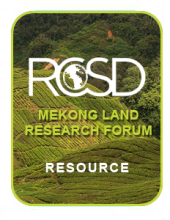Land Library Search
Through our robust search engine, you can search for any item of the over 73,000 highly curated resources in the Land Library.
If you would like to find an overview of what is possible, feel free to peruse the Search Guide.
/ library resources
Showing items 100 through 108 of 1368.Poverty reduction has become a worldwide promise, yet the term itself has been commonly abused to legitimize development policies and projects with truly questionable impacts on the poor.
Cambodia has long had a difficult mix of resource wealth and weak land governance, a function of its legacy of enduring postwar conflict and neoliberal development policies of the 1990s.
Land tenure in Vietnam is becoming increasingly contested in the context of rapid economic development and growing inequality. Agricultural land in and around cities is targeted by developers for conversion to commercial uses.
Farm incomes in rural Vietnam are tightly constrained by very small farm sizes.
ABTRACTED FROM FIRST PARAGRAPH: Cambodia’s forests are vital components of the highly threatened Indo-Burma biodiversity hotspot.
In Cambodia, the interactions between large-scale land investment and land titling gathered particular momentum in 2012–13, when the government initiated an unprecedented upland land titling programme in an attempt to address land tenure insecurity where large-scale land investment overlaps with
Namati offers this brief in the hope that Myanmar’s national reforms and the implementation of the country’s new National Land Use Policy can grow from the lived experience of ordinary Myanmar citizens.
The Asia-Pacific region is a hotspot for forest landscape conflicts which are played out between local communities and outsiders such as government agencies and private companies.
This paper uses panel data at commune, household, and plot levels to study the causes and effects of agricultural land fragmentation in rural Viet Nam.

